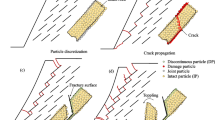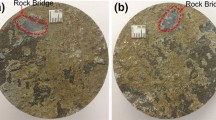Abstract
The effect of joint overlap on the full failure behavior of a rock bridge in the shear-box test was numerically investigated by means of the particle flow code in two dimensions (PFC2D). Initially, the PFC2D was calibrated by use of data obtained from experimental laboratory tests to ensure the conformity of the simulated numerical model’s response. Furthermore, validation of the simulated models was cross-checked with the results from direct shear tests performed on non-persistent jointed physical models. By use of numerical direct shear tests, the failure process was visually observed and the failure patterns were seen to be in reasonable accordance with experimental results. Discrete element simulations demonstrated that macro shear fractures in rock bridges are because of microscopic tensile breakage of a large number of bonded discs. The failure pattern is mostly affected by joint overlap whereas the shear strength is closely related to the failure pattern. The results show that non-overlapping joints lost their loading capacity when nearly 50 % of total cracks developed within the rock bridge whereas the overlapping joints lost their loading capacity as soon as cracks initiated from the joint walls. Furthermore, progressive failure or stable crack growth was seen to develop for non-overlapped joints whereas brittle failure or unstable crack growth was seen to develop in overlapped joints.



















Similar content being viewed by others
Explore related subjects
Discover the latest articles and news from researchers in related subjects, suggested using machine learning.References
Einstein HH, Veneziano D, Baecher GB, O’Reilly KJ (1983) The effect of discontinuity persistence on rock slope stability. Int J Rock Mech Min Sci Geomech Abstr 20(5):227–236
Gehle C, Kutter HK (2003) Breakage and shear behavior of intermittent rock joints. Int J Rock Mech Min Sci 40:687–700
Ghazvinian A, Nikudel MR, Sarfarazi V (2007) Effect of rock bridge continuity and area on shear behavior of joints. 11th congress of the international society of rock mechanics, Lisbon, Portugal
Ghazvinian A, Sarfarazi V, Schubert W, Blumel M (2011) A study of the failure mechanism of planar non-persistent open joints using PFC2D. Rock Mech Rock Eng J 45:677–693
Itasca (1999) PFC2D—Particle Flow Code in 2 Dimensions. Theory and background. Itasca Consulting Group, Minneapolis, MN, pp 1–124
Lajtai EZ (1969a) Strength of discontinuous rocks in direct shear. Geotechnique 19:218–332
Lajtai EZ (1969b) Shear strength of weakness planes in rock. Int J Rock Mech Min Sci 6:499–515
Patton FD (1996) Multiple modes of shear failure in rock, Proceedings of the First International Congress on Rock Mech. ISRM Lisbon 1:509–513
Potyondy DO, Cundall PA (2004) A bonded-particle model for rock. Int J Rock Mech Min Sci 41:1329–1364
Savilahti T, Nordlund E, Stephansson O (1990) Shear box testing and modeling of joint bridge. In: Proceedings of international symposium on shear box testing and modeling of joint bridge Rock Joints, Norway, 295–300
Scavia C (1999) The displacement discontinuity method for the analysis of rock structures: a fracture mechanic. In: Aliabadi MH (ed) Fracture of Rock. WIT press, Computational Mechanics Publications, Boston, pp 39–82
Scavia C, Castelli M (1996) In: Barla G (ed) Analysis of the propagation of natural discontinuities in rock bridges, EUROCK’98. Balkema, Rotterdam, pp 445–451
Vasarhelyi B, Bobet A (2000) Modeling of crack initiation, propagation and coalescence in uniaxial compression. Rock Mech Rock Eng 33(2):119–139
Wong RHC, Chau KT, Tsoi PM, Tang CA (1999) Pattern of coalescence of rock bridge between two joints under shear testing. In: Vouile G, Berest P (eds) The 9th international congress on rock mechanics, Paris, pp 735–738
Wong RHC, Leung WL, Wang SW (2001) Shear strength study on rock-like models containing arrayed open joints. In: Elsworth D, Tinucci JP, Heasley KA (eds) Rock mechanics in the national interest. Swets & Zeitlinger Lisse, Leiden, pp 843–849. ISBN: 90-2651-827-7
Acknowledgments
Support received from the Graz University of Technology, Graz, Austria, is gratefully acknowledged.
Author information
Authors and Affiliations
Corresponding author
Rights and permissions
About this article
Cite this article
Sarfarazi, V., Ghazvinian, A., Schubert, W. et al. Numerical Simulation of the Process of Fracture of Echelon Rock Joints. Rock Mech Rock Eng 47, 1355–1371 (2014). https://doi.org/10.1007/s00603-013-0450-3
Received:
Accepted:
Published:
Issue Date:
DOI: https://doi.org/10.1007/s00603-013-0450-3




